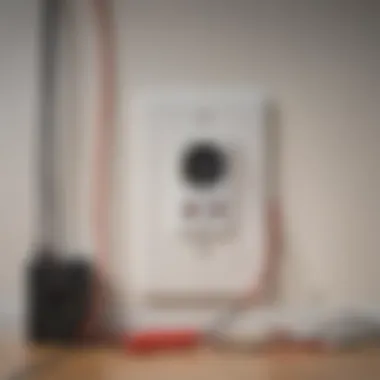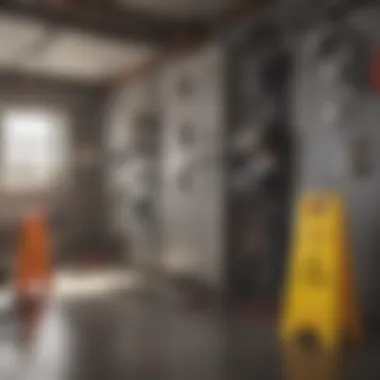Troubleshooting Electrical Issues in One Room


Intro
Dealing with electrical issues can be frustrating and sometimes confusing. When electricity fails in a specific room, it can disrupt daily activities and create a sense of unease. Understanding the potential causes and knowing how to approach the problem can demystify the situation. This article will provide essential insights and solutions tailored for homeowners and design enthusiasts alike, helping them tackle electrical failures with confidence.
Recognizing the signs of an electrical problem early is crucial. This guide will deliver information on common issues, effective troubleshooting techniques, and when to seek professional help. With this knowledge, readers will be empowered to maintain safe and functional living spaces. By addressing the varying aspects of electrical problems, we aim to enhance not only the understanding of household wiring but also the overall safety and aesthetics of the environment.
Prelude to Electrical Issues in Residential Spaces
Electrical issues can profoundly impact the comfort and functionality of a home. Understanding the fundamentals of electrical systems is not just beneficial for homeowners, but also crucial for design enthusiasts and real estate professionals. An awareness of potential issues can empower individuals to take proactive measures, thus preserving both the aesthetic and practical qualities of their living spaces.
The significance of addressing electrical problems in a residential environment lies not only in restoration but also in prevention. When electricity fails in a specific room, it can indicate potentially severe underlying issues that could potentially escalate if left unattended. Recognizing early symptoms can save both time and money.
Moreover, familiarity with your home's electrical system enhances safety. Electrical failures can present risks such as fire hazards or electrocution. For this reason, having basic knowledge on troubleshooting can equip you with the skills needed to navigate these challenges safely.
Taking this into account, the benefits of understanding electrical issues are multifold:
- Informed Decision Making: Homeowners who grasp the basics can make better choices regarding when to attempt repairs and when to seek professional help.
- Increased Safety: Identifying potential hazards can prevent accidents, ensuring the home remains a safe space for family and friends.
- Preservation of Property Value: Properly maintained electrical systems contribute to the overall appeal and value of a home, making it more attractive to potential buyers.
In summary, educating oneself about electrical issues in residential spaces not only fosters a safer living environment but also enhances home value and functionality. This article aims to guide readers through the various components of electrical systems, enabling them to troubleshoot effectively and maintain their homes with confidence.
"A proactive approach to electrical management is essential in any household, as it not only safeguards your property but also enriches your living experience."
Ultimately, this understanding serves as a critical foundation for tackling the complexities that come with electrical failure in any room.
Understanding the Basics of Household Electrical Systems
Understanding how household electrical systems function is essential for homeowners. It provides insights into why power outages may occur in a specific room. This knowledge can aid in troubleshooting and prevent future issues. Knowing the layout of your electrical system can save time and potentially reduce repair costs. There are several key components to consider, including electrical circuits, wiring elements, and protective devices like breakers and fuses.
Overview of Electrical Circuits
At the core of household electrical systems are electrical circuits. A circuit is essentially a pathway that electricity travels through. Think of it as a closed loop that connects the power source to various outlets and appliances. Each circuit is wired to carry a specific load, which is based on the capacity of the conductive material used in wiring. In most homes, circuits are organized into two types: general purpose and dedicated circuits. General purpose circuits supply power to outlets and lighting fixtures, while dedicated circuits are reserved for high-demand appliances like refrigerators or air conditioning.
Understanding your home’s circuit layout can help in pinpointing issues when certain areas lose power. It’s also important to know how circuits are protected. For instance, if a circuit is overloaded, it can cause wiring to heat up, leading to potential hazards.
Components of Electrical Wiring
The components of electrical wiring are an essential part of how electricity is delivered throughout your home. The main types of wiring found in electrical systems are non-metallic sheathed cable, armoured cable, and conduit. Non-metallic sheathed cable is the most common, used mainly for general-purpose circuits. Armoured cable serves as a durable alternative, ideal for locations where additional protection is needed.
Other important elements include junction boxes, which contain electrical connections and allow for safe access to parts of the wiring system. Additionally, outlets and switches are integral for controlling the flow of electricity to devices within a room.
Each component must be installed properly to ensure safety and functionality. Faulty wiring can lead to the aforementioned electrical failures, making a basic understanding of wiring essential for effective troubleshooting.
Role of Breakers and Fuses
Breakers and fuses play a critical role in protecting electrical systems from overloads and short circuits. A breaker is a switch that automatically interrupts the circuit when it detects an excess of current. Fuses work on a similar principle but use a wire that melts when excess current passes through it, thereby stopping the flow.
Both devices are crucial safety features. They prevent potential fire hazards caused by overheating and protect other components of the electrical system. It is vital to familiarize oneself with how these devices operate and how to reset or replace them when necessary.
Proper knowledge of breakers and fuses can save you from extensive damages or costly repairs.
In summary, understanding the basics of household electrical systems empowers homeowners. It enhances their ability to identify and troubleshoot issues confidently. Power failures are not just inconvenient; they can disrupt lives. Knowing the underlying systems can lead to effective solutions.
Identifying Symptoms of Electrical Failure
Identifying the symptoms of electrical failure is a crucial first step for understanding and resolving issues within your household. A timely recognition of these symptoms not only aids in diagnosing the problem but also can prevent further complications that may arise if left untreated. Knowing the common indicators of electrical problems enhances your ability to address them swiftly, ensuring a safe and functional living environment. Each of the symptoms discussed here reflects different underlying causes, which can implement different troubleshooting methods. By familiarizing yourself with these indicators, you can make informed decisions about the necessary steps to take.


Loss of Power in Only One Room
A loss of power in a single room can indicate several potential faults. When you experience a complete blackout in just one area of your home, it suggests that the issue is not with your entire electrical system but likely localized to that room. Possible reasons for this could involve a tripped circuit breaker or a blown fuse connected to that particular room. It’s also a reminder to check for any recent changes to the wiring or the addition of new appliances that require substantial power, which could overload the circuit.
Some signs to look for include:
- Outlets that do not work. Attempt to plug in different devices to rule out appliance faults.
- Lights flickering or dimming. This could signal a demand exceeding capacity.
- Strange sounds or smells. A burning smell or unusual sounds could hint toward wiring issues.
Fuse or Circuit Breaker Issues
Fuses and circuit breakers exist as safety features within electrical systems. They help to prevent overloads by cutting off power when necessary. If you notice that the circuit breaker is frequently tripped or a fuse needs replacing often, it could signal an ongoing issue. Over time, circuit breakers can wear out or malfunction, leading to intermittent power failures directed at specific rooms.
Consider these aspects when examining your breakers or fuses:
- Check for tripped breakers or blown fuses. Reset or replace them accordingly, keeping safety in mind.
- Look for signs of damage. Burn marks or rust can indicate deterioration.
- Evaluate loads on different circuits. If one circuit frequently experiences issues while others remain unaffected, redistribution of devices may be necessary.
Unresponsive Outlets and Switches
Unresponsive outlets and switches represent a direct symptom of electrical failure. If certain outlets or light switches do not respond, it could stem from several problems like faulty wiring, bad connections, or damaged components. This is often frustrating as it limits the functionality of the room.
To troubleshoot this issue:
- Test multiple devices. Make sure the issue is not with the appliances being used.
- Inspect for loose connections. Carefully check outlet faces and switch plates for any visible damage.
- Use a multimeter. This device can help measure the electrical current passing through outlets.
Understanding these symptoms allows for a systematic approach to troubleshooting electrical failures. Recognizing the roots of such issues leads to effective solutions.
Common Causes for Electrical Failure in One Room
Understanding the common causes of electrical failure in just one room is essential for effectively troubleshooting such issues. By identifying these factors, homeowners can save time, minimize repair costs, and ensure safety. Each cause can also lead to varying symptoms, making it critical to recognize specific signs associated with each type of failure. This section will delve into three principal causes: circuit overload, faulty wiring, and defective outlets or switches.
Circuit Overload
A circuit overload occurs when a circuit becomes burdened by too many electrical devices drawing power simultaneously. This situation often arises in rooms where multiple appliances or electronics are used, such as home offices or entertainment rooms.
- Common Signs:
- Tripped circuit breakers
- Flickering lights
- Warm outlets or cords
To address a circuit overload, one must first unplug or redistribute the electrical load across different circuits. Avoid plugging multiple high-wattage devices into the same outlet. If the issue persists, it may be advisable to consult an electrician to evaluate the circuit capacity and possibly rewire for additional outlets.
Faulty Wiring
Faulty wiring is another crucial factor contributing to electrical failure. It can result from improper installation, age, or damage to the wiring infrastructure.
- Indicators of Faulty Wiring:
- Frequent circuit breaker trips
- Burning smells or scorch marks around outlets
- Buzzing sounds from switches or outlets
Detecting faulty wiring can be more complicated than identifying overload issues. Homeowners should conduct visual inspections, looking for frayed wires or loose connections. If any suspicions arise, it is wise to refrain from using the affected circuits and seek professional assessment immediately. Ignoring such warnings can result in serious hazards, including fire risks.
Defective Outlets or Switches
Defective outlets or switches may also cause localized electrical failure. Over time, these components can wear out or sustain damage, leading to ineffective power delivery.
- Symptoms of Defective Units:


- Outlets that do not hold plugs securely
- Switches that don't function properly
- Discoloration or a hot feeling near the outlet or switch
To troubleshoot, start by testing each outlet and switch using a simple device, like a lamp. If an outlet is unresponsive, it is advisable to check the circuit breaker first. If the breaker is not tripped, the outlet or switch may need replacing. This task can be performed by a homeowner with basic skills or a professional for more confidence.
Always remember that working with electricity carries risks. If in doubt, calling an electrician can ensure thorough and safe troubleshooting.
Basic Troubleshooting Steps
The basic troubleshooting steps serve as the foundation for addressing electrical failures in one room. Understanding these steps is crucial because it allows homeowners to identify issues quickly, potentially saving time and money. When one room loses power, systematic troubleshooting can often reveal the problem without the need for professional intervention. Moreover, knowing how to handle these basic tasks instills a sense of confidence.
Inspecting Circuit Breakers
Inspecting circuit breakers is a priority when troubleshooting electrical problems. Your circuit breaker panel is the central hub that regulates the flow of electricity throughout your home. If a circuit breaker trips, it disrupts power to specific areas, causing unexpected outages. Begin by locating the breaker panel, which is usually situated in a basement, garage, or utility room. Each breaker should be labelled, indicating the corresponding room or appliance it controls.
When you inspect these breakers, look for any that are in the 'off' position or appear to be tripped. Resetting a breaker is as simple as flipping it fully to the 'off' position and then back to 'on'. This action may restore power. However, if the breaker trips again immediately, this could indicate a more serious underlying issue, such as an overload or a short circuit in the wiring. In such cases, it is wise to consult a professional electrician instead of attempting further repairs.
Testing Outlets
Testing outlets is the next logical step in diagnosing electrical issues. It is essential to determine whether the outage is affecting just one outlet or multiple outlets in the room. A simple outlet tester is useful in this case. These devices can easily be found at home improvement stores and provide immediate feedback about the outlet’s status. Just plug the tester into the outlet, and observe the indicator lights; they signal if the outlet is functioning correctly.
Also, consider unplugging any connected devices before testing. If the outlet appears dead, try another outlet in the room to check if there is a more widespread issue. If you determine that the outlet is faulty, it may require replacement. Keep in mind, working on outlets involves dealing with live electrical wires. Therefore, always prioritize safety and, when in doubt, consider calling in a professional electrician.
Examining Appliances
Sometimes the cause of electrical issues lies not in the wiring or outlets but in appliances themselves. To examine appliances, first, unplug them from the outlet. Inspect the power cords for any visible damage or wear. If the cord appears frayed or broken, it could be the cause of the malfunction. Next, consider trying a different appliance in the same outlet to determine if the outlet works properly.
If the outlet is functional and the appliance still does not work, it may be a sign of appliance failure. Conducting a basic troubleshooting on the specific appliance can often help. Check the user manual for any troubleshooting steps recommended by the manufacturer.
Always remember, when dealing with electrical issues, safety is paramount. Use appropriate protective gear and turn off power from the breaker before starting any repairs.
In summary, these basic troubleshooting steps—inspecting circuit breakers, testing outlets, and examining appliances—offer a methodical approach to identifying the source of electrical failure. By addressing these areas first, you can often resolve the issue with minimal intervention. As you become adept at these tasks, you may find that electrical troubleshooting becomes a less daunting challenge.
Safety Considerations When Handling Electrical Issues
Addressing electrical problems in a residential setting necessitates a robust understanding of safety measures. Electrical systems can pose serious risks, including fire hazards and personal injury. Hence, prioritizing safety is critical. Proper safety protocols reduce the likelihood of accidents, promote a secure environment for repair activities, and protect both individuals and property from potential damage.
Safely managing electrical issues involves a few key elements. First, it encompasses the right tools and equipment. Having the appropriate gear minimizes the risk of electrical shock. Second, it involves an awareness of one’s environment. Recognizing when something is off can prevent accidents before they happen. Third, continuous education about electrical systems can fortify one’s ability to handle issues responsibly.
In summary, embracing safety considerations when troubleshooting electrical issues is not just advisable; it is essential. It ensures the well-being of homeowners and maintains the integrity of their living spaces.
Personal Safety Protocols
When handling electrical problems, personal safety protocols are fundamental. Start by turning off the power to the affected area. This can usually be done at the circuit breaker. Do not assume that the power is off; it is wise to use a multimeter or voltage tester to confirm this.
Next, wear protective gear such as rubber-soled shoes and insulated gloves. These items decrease the risk of electric shock. Keep your hands dry, and avoid working in wet areas. It is also crucial to have one person work on the electrical task while another remains outside the work zone, reporting any needs or updates. This reduces distractions and ensures that help is readily available.
Keep your workspace organized. This way, you can quickly access necessary tools and avoid hazardous situations where you might trip over cords or tools scattered around. Lastly, do not hesitate to call for support if uncertainties arise.
Recognizing Hazardous Situations
Properly identifying hazardous situations is a crucial aspect of electrical safety. Several indicators signal possible dangers. For instance, if you notice flickering lights, scorched outlets, or an unusual burning smell, these could suggest underlying issues that warrant immediate attention.
Furthermore, always be wary of exposed wires or overloaded power strips. These situations can easily escalate into more severe problems.
"Never underestimate the signs. Ignoring them can lead to severe consequences."


If your circuit breaker frequently trips, it may indicate an overloaded circuit. Each of these warning signs should prompt a cautious approach to further investigate the situation.
Remember: if danger is perceived, it is better to err on the side of caution and consult a qualified electrician. Assessing hazards correctly forms the foundation for safe electrical practices in the home.
When to Seek Professional Help
When dealing with electrical issues, it is crucial to recognize when a situation goes beyond personal troubleshooting abilities. While many electrical problems can be resolved with basic knowledge and tools, there are moments when the complexity or danger of a situation necessitates professional intervention. Seeking the help of qualified electricians provides numerous benefits including safety, efficiency, and expertise that are often unavailable to the average homeowner.
Health and safety is paramount. Electricity poses inherent risks, including electric shocks, fires, or severe injuries resulting from mishandling. Knowing the severity of issues can guide homeowners toward making informed decisions. Furthermore, qualified electricians bring a wealth of experience to the table. Their training allows them to identify underlying issues that might not be immediately apparent. In short, when faced with uncertainty, consulting a professional can save time and mitigate potential hazards.
Indicators of Severe Issues
Recognizing indicators of severe electrical issues can distinguish between a minor inconvenience and a significant problem. Homeowners should be vigilant for the following signs:
- Flickering lights: Frequently flickering or dimming lights can indicate a larger problem in the wiring or circuit.
- Burning odors: A burnt smell, possibly from outlets or switches, denotes that wires might be overheating and could lead to fire.
- Buzzing sounds: Represents electrical arcing, which can be dangerous and indicates that immediate attention is needed.
- Tripping circuit breakers: Regularly tripped breakers can signify overloads or compromised circuits.
- Visible damage: Any signs of fraying wires or scorch marks require expert assessment.
If any of these symptoms are noted, it is advisable to cease using the affected circuits and contact a professional electrician. Ignoring these warning signs can lead to more severe consequences.
Choosing a Qualified Electrician
Selecting an electrician is a decision that should be made with a certain level of diligence. Not all electrical professionals offer the same level of service or expertise. Consider the following points when choosing one:
- Licensing and insurance: Ensure the electrician holds the necessary licenses and insurance. This not only protects them but also protects the homeowner.
- Experience: Look for professionals with a strong track record in handling similar issues. Experienced electricians often have insights and methods developed through practical exposure.
- References and reviews: Seek references from previous clients or read online reviews. Positive feedback can offer confidence in their abilities.
- Estimates and transparency: A reliable electrician should provide clear estimates and be willing to explain the work that needs to be done as well as the associated costs.
The right professional can make a significant difference in resolving electrical problems efficiently and safely, ensuring that systems function correctly and reducing any potential hazards.
Preventative Measures for Future Electrical Issues
Being proactive is crucial when it comes to managing electrical systems in your home. Preventative measures help reduce the risk of electrical failures, ensuring that your living spaces function effectively and safely. These strategies can save you time, money, and hassle in the long run. In this section, we will examine the significance of regular maintenance and upgrading outdated systems to maintain electrical reliability.
Regular Electrical Maintenance
Regular electrical maintenance is essential for the longevity and efficiency of your household systems. Just like any other component of your home, the electrical system requires routine checks to ensure that everything is operating correctly. Regular inspections can help identify potential issues before they escalate into larger, more costly problems.
Key aspects of regular maintenance include:
- Periodic Inspection: Schedule professional inspections at least once a year. A qualified electrician can identify any wear and tear that may not be visible to the untrained eye.
- Cleaning Connections: Dust and debris can accumulate on electrical connections. Clean connections can prevent overheating and reduce risk of fire hazards.
- Testing Circuit Breakers: Ensure that circuit breakers function properly by testing them periodically. This can help avoid sudden power losses.
- Checking for Signs of Wear: Look for frayed wires, discolored outlets, or any unusual smells that could indicate faulty wiring.
Taking these steps not only improves safety but also adds value to your property. Regular maintenance enhances energy efficiency, which can lead to lower electricity bills and a more sustainable home environment.
Upgrading Outdated Systems
Upgrading outdated electrical systems is another vital preventative measure. Many homes still utilize old wiring that doesn't meet current safety standards, posing significant risks. Modernizing these systems can drastically improve both the safety and efficiency of your electrical network.
Here are some important benefits of upgrading:
- Increased Safety: Newer systems significantly reduce the risk of electrical fires and electrocution. Upgrading can involve replacing old wiring, outlets, and breakers.
- Enhanced Energy Efficiency: New technologies can lead to reduced energy consumption, hence lowering electricity costs. Energy-efficient appliances can also reduce the overall load on the electrical system.
- Improved Compatibility: As technology evolves, homes must adapt. Upgraded systems can support smart home devices and energy-efficient appliances, providing more convenience.
- Compliance with Code: Upgrading helps ensure that all installations meet the latest electrical codes and standards. This minimizes legal liabilities and enhances homeowner peace of mind.
Remember: Investing in your electrical infrastructure today can prevent major inconveniences and costs down the line.
Closure
In this article, we explored the complexities of electrical failures that manifest in a single room within a household. Understanding the causes, diagnostic techniques, and solutions allows homeowners to effectively manage these issues. It is crucial to know that electrical problems can range in severity, and recognizing when to address them personally or when to engage professional service plays a pivotal role in maintaining safety and functionality.
One significant takeaway from this discussion is the importance of regular electrical maintenance. Engaging in preventative measures can significantly diminish the occurrence of future electrical failures. Homeowners should also prioritize upgrading any outdated systems. These steps not only enhance the functionality of the electrical system but also contribute to overall home safety and efficiency.
Furthermore, the article addresses the specific symptoms that indicate electrical trouble, such as unresponsive outlets or circuit overloads. By recognizing these signs early on, timely action can be taken before minor issues escalate into more severe problems. This proactive approach is invaluable, especially for individuals involved in interior design or real estate, as it ensures that living environments remain both functional and aesthetically pleasing.
Finally, the importance of safety cannot be overstated. Utilizing personal safety protocols when troubleshooting electrical problems safeguards not only the individual but also the household. In cases where the problems are complex or hazardous, consulting a qualified electrician becomes essential. The implications of neglecting these aspects can lead to greater risks, including electrical fires or severe property damage.
By synthesizing the information presented throughout the article, it is clear that addressing electrical issues with knowledge and confidence equips homeowners and design enthusiasts with the capacity to navigate their living environments safely. In this way, they can not only preserve but also enhance the aesthetic appeal and comfort of their spaces.







